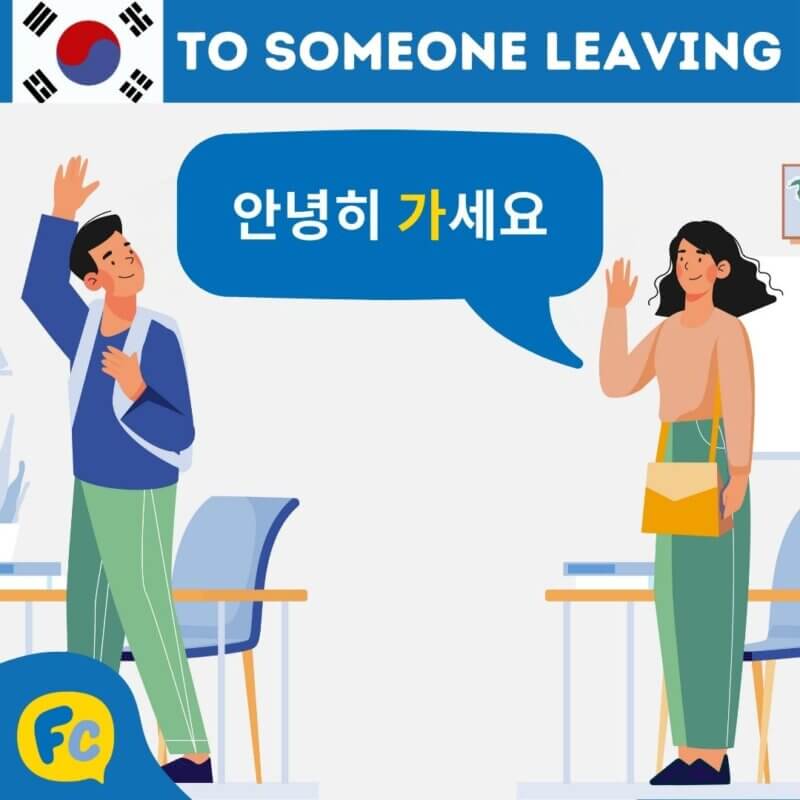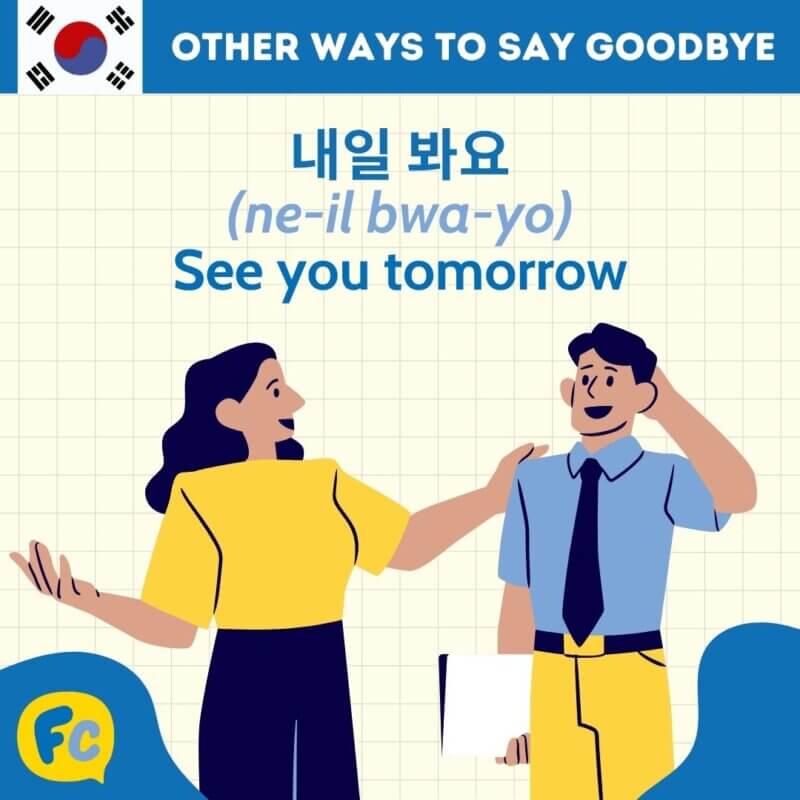How to Say GoodBye in Korean // Informal to Formal Phrases
Cherish Every Goodbye
Discover How to Bid Farewell in Korean!

👋Saying goodbye in Korean isn’t so simple.
In English, the word goodbye could be used in almost every situation to bid farewell. Basically, goodbyes become a tad complicated in Korean because the expression changes depending on who is leaving and who is staying.
Here are the most common ways to say goodbye in Korean:
Informal: 잘 가 (jal ga) – Used with close friends or younger people.
Standard: 안녕히 가세요 (annyeonghi gaseyo) – Said to someone leaving. 안녕히 계세요 (annyeonghi gyeseyo) – Said if you are the one leaving
Formal: 안녕히 가십시오 (annyeonghi gasipsio) / 안녕히 계십시오 (annyeonghi gyesipsio) – Very polite, used in formal settings.
More details and ways to say goodbye below…
How to Say Goodbye in Korean | Two Basic Types of Goodbyes
How to Say Goodbye in Korean | Other Ways to Say Goodbye In Korean
How to Say Goodbye in Korean | Quiz
How to Say Goodbye in Korean | FAQ
Two Basic Types of Goodbyes
There are 0️⃣2️⃣ types of goodbye in Korean.


| Korean | transliteration | English |
|---|---|---|
| 안녕히 계세요 | an-nyeong-hee ge-se-yo | Goodbye (to someone staying) |
| 안녕히 가세요 | an-nyeong-hee ga-se-yo | Goodbye (to someone leaving) |
If you’ve been following our blogs, 안녕 (anyeong) might be a familiar word.
안녕 (an-nyeong) is the word used for greeting someone.
| Korean | Romanization | English Translation |
|---|---|---|
| 안녕하십니까 | an-nyeong-ha-sip-ni-kka | Hello (most formal) |
| 안녕하세요 | an-nyeong-ha-se-yo | Hello (more formal and commonly used) |
| 안녕 | an-nyeong | Hello (informal) |

How to Say Hello in Korean // It’s Not As Simple As It Sounds
Learning Hello in Korean isn’t as easy as learning just one word. In Korean, there are multiple ways to say hello! Don’t worry, we are here to explain.
안녕 (安寧) is a word rooted in the Chinese word that means calm and peaceful.
| Korean Phrase | transliteration | English |
|---|---|---|
| 안녕하세요 | an-nyeong-ha-se-yo | Are you peaceful? (common greeting) |
| 안녕히 계세요 | an-nyeong-hee ge-se-yo | Stay peacefully / Stay well |
| 안녕히 가세요 | an-nyeong-hee ga-se-yo | Go peacefully |
Here is the breakdown of what each word means and what it means when combined.
| Korean | Romanization | English Translation |
|---|---|---|
| 안녕 | an-nyeong | Peace |
| 히 | hee | Adverbial phrase modifying 안녕 (an-nyeong) |
| 계시다 | ge-si-da | To stay |
| 계세요 | ge-se-yo | Formal conjugated form of 계시다 (ge-si-da) |
| 안녕히 계세요 | an-nyeong-hee ge-se-yo | Stay peacefully / Stay well |
In the sequence of formality:
안녕히 계십시오 (an-nyeong-hee ge-sip-si-yo) – most formal
안녕히 계세요 (an-nyeong-hee ge-se-yo) – more formal and most common
| Korean | transliteration | English Translation |
|---|---|---|
| 안녕 | an-nyeong | Informal: Peace |
| 히 | hee | Adverbial phrase modifying 안녕 (an-nyeong) |
| 가시다 | ga-si-da | To go |
| 가세요 | ge-se-yo | Formal conjugated form of 가시다 (ga-si-da) |
| 안녕히 가세요 | an-nyeong-hee ga-se-yo | Go peacefully / Hope you will go well (have a safe journey) |
In the sequence of formality:
| Korean | transliteration | “go peacefully” |
|---|---|---|
| 안녕히 가십시오 | an-nyeong-hee ga-sip-si-yo | Most formal |
| 안녕히 가세요 | an-nyeong-hee ga-se-yo | More formal and most common |
| 안녕 | an-nyeong | Informal |
Did you notice?
📍안녕 (an-nyeong), the informal way to say goodbye also means hello!
Now that you understand what both goodbyes mean, you just need to choose which one to use.
If you are staying and the person you are bidding farewell is leaving you will use 안녕히 가세요 (an-nyeong-hee ga-se-yo), wishing them a safe journey.
If you are leaving and want to say goodbye, you will use 안녕히 계세요 (an-nyeong-hee ge-se-yo), wishing for their safety and peace.
Let’s put these expressions into examples.
class="wp-block-table has-text-align-center 가세요 data-align="center">Honorific used to address someone or occupation data-align="center">In peace class="wp-block-quote">교수님 안녕히 가십시오 (gyo-su-nim an-nyeong-hee ga-sip-si-yo)
Goodbye Professor (when you are staying)
[speak 선생님 안녕히 가세요 (seon-saeng-nim an-nyeong-hee ga-se-yo)
Goodbye Teacher (when you are staying)
class="wp-block-table data-align="center">Korean data-align="center">Honorific used to address someone or occupation data-align="center">In data-align="center">an-nyeong-hee data-align="center">Conjugated form of 가시다 (ga-si-da) – Go peacefully class="wp-block-quote">[speak 유미야 안녕 (Yoomi-ya an-nyeong) or 안녕 유미야 (an-nyeong Yoomi-ya)
Bye Yoomi (both staying or leaving)
class="wp-block-table has-text-align-center data-align="center">Korean 계십시오 data-align="center">Honorific used to address someone or occupation data-align="center">In data-align="center">an-nyeong-hee data-align="center">Conjugated form of 계시다 (ge-si-da) – To stay class="wp-block-quote">교수님 안녕히 계십시오 (gyo-su-nim an-nyeong-hee ga-sip-si-yo)
Goodbye Professor (when you are leaving)
[speak 선생님 안녕히 계세요 (seon-saeng-nim an-nyeong-hee ge-se-yo)
Goodbye Teacher (when you are leaving)
| Korean | transliteration | English |
|---|---|---|
| 선생 | seon-saeng | Teacher |
| 님 | nim | Honorific used to address someone or occupation politely |
| 안녕히 | an-nyeong-hee | In peace |
| 계세요 | an-nyeong-hee ga-se-yo | Conjugated form of 계시다 (ge-si-da) – To stay |
유미야 안녕 (Yoomi-ya an-nyeong) or 안녕 유미야 (an-nyeong Yoomi-ya)
Bye Yoomi (both staying or leaving)
Other Ways to Say Goodbye In Korean
Besides these two common forms there are other ways we can say goodbye.
가세요 (gaseyo) – Farewell, Goodbye

The expression 가세요 (ga-se-yo) is often used as a short form for 안녕히 가세요 (an-nyeong-hee ga-se-yo). It’s similar to how people usually say bye instead of goodbye.
The most formal way to say 가세요 (ga-se-yo) is 가십시오 (ga-sip-si-yo).
The casual form is just 가 (ga). But close friends will often say 잘 가(jal ga) instead as sometimes a single word can sound a bit too short.
| Korean | Romanization | English Translation |
|---|---|---|
| 잘 | jal | Well |
| 가 | ga | Go |
Contrary to the popular expression 가세요 (ga-se-yo), we won’t usually say 계세요 (ge-se-yo) or 계십시오 (ge-sip-si-yo) to say goodbye to someone.
We WILL, however, use 잘 있어 (jal it-seo) – stay well to close friends.
So use 잘 가 (jal ga) when you are staying and 잘 있어 (jal it-seo) when you are leaving.
Simply put the person’s name in the front or at the end to say goodbye.
For example:
| Korean | transliteration | english |
|---|---|---|
| 유미야 잘 가 | Yoomi-ya jal ga | Bye Yoomi (when you are staying) |
| 잘 가 유미야 | jal ga Yoomi-ya | |
| 유미야 잘 있어 | Yoomi-ya jal it-seo | Bye Yoomi (when you are leaving) |
| 잘 있어 유미야 | jal it-seo Yoomi-ya |
내일 봐요 (ne-il bwa-yo) – See you tomorrow

| Korean | transliteration | English |
|---|---|---|
| 내일 | ne-il | Tomorrow |
| 보다 | bo-da | To see |
| Korean | transliteration | English |
|---|---|---|
| 내일 뵙겠습니다 | ne-il bwep-get-sum-ni-da | I will see you tomorrow (most formal) |
| 내일 봬요 | ne-il bwe-yo | I will see you tomorrow (slightly formal) |
| 내일 봐요 | ne-il bwa-yo | I will see you tomorrow (more formal) |
| 내일 봐 | ne-il bwa | See you tomorrow (casual) |
The reason why 봬요 (bwe-yo) is slightly more formal than 봐요 (bwa-yo) is because the
봬요 (bwe-yo) is used for people you need to show respect to. 봐요 (bwa-yo) is usually used in casual situations. Simply put use:
| Korean | transliteration | Usage description |
|---|---|---|
| 내일 봐요 | ne-il bwa-yo | To people you are familiar with, same age but not too close to be completely casual. |
| 내일 봬요 | ne-il bwe-yo | To people you are familiar with but older than you. |
다음에 봐요 (da-eum-e bwa) – See you next time, see you later

| Korean | transliteration | english |
|---|---|---|
| 다음 | da-eum | Next time |
| 에 | e | Particle used after a time expression, like 다음 (da-eum) |
| 보다 | bo-da | To see |
| Korean | transliteration | formality level |
|---|---|---|
| 다음에 뵙겠습니다 | da-eum-e bwep-get-sum-ni-da | Most formal |
| 다음에 봬요 | da-eum-e bwe-yo | Slightly more formal than below |
| 다음에 봐요 | da-eum-e bwa-yo | More formal |
| 다음에 봐 | da-eum-e bwa | Casual |
Just like the example above use:
| Korean | transliteration | english |
|---|---|---|
| 다음에 봬요 | da-eum-e bwe-yo | To people you are familiar with, same age but not too close to be completely casual. |
| 다음에 봐요 | da-eum-e bwa-yo | To people you are familiar with but older than you. |
Now that you learned the different ways to say goodbyes, let’s put them into practice the next time you meet your Korean friend.
Remember, practice makes improvements!
We’ll be back with more exciting topics. So stay tuned!
USEFUL VOCABULARY
👇 We should have you pretty well covered with the following vocabulary and phrases:
| Korean | Transliteration | English |
|---|---|---|
| 안녕히 계세요 | an-nyeong-hee ge-se-yo | Stay well |
| 안녕히 가세요 | an-nyeong-hee ga-se-yo | Go well (safe journey) |
| 안녕 | an-nyeong | Peace / Hello / Goodbye |
| 계시다 | ge-si-da | To stay |
| 가시다 | ga-si-da | To go |
| 교수님 | gyo-su-nim | Professor |
| 선생님 | seon-saeng-nim | Teacher |
| 님 | nim | Honorific for polite address |
| 잘 가 | jal ga | Go well (informal) |
| 잘 있어 | jal it-seo | Stay well (informal) |
| 내일 봐요 | ne-il bwa-yo | See you tomorrow |
| 다음에 봐요 | da-eum-e bwa-yo | See you next time/later |
| 빠이 | bba-yee | Bye (informal, from English) |
| 뿅 | bbyong | Goodbye (text, disappearing) |
| 반갑습니다 | ban-gap-seup-ni-da | Nice to meet you |
| 하십시오체 | hasipsioche | Extremely polite speech level |
| 해요체 | haeyoche | Polite but casual speech level |
| 반말 | banmal | Informal speech |
| 또 봐요 | tto bwa-yo | See you again |
| 태극기 | tae-geuk-gi | Korean national flag |
Don’t forget to check out our Flexi Classes & our Korean Blog
👉 How to say Good Morning in Korean
How to Say Goodbye in Korean | Quiz
Have you correctly learned the Korean vocabulary on this page?
Have a try right now and get immediate results:
How to Say Goodbye in Korean | FAQ
What is another way to say goodbye in Korean??
빠이 (bba-yee) bye
Just an exaggerated version of the English word BYE.
What is a popular way Koreans say goodbye in text messages?
뿅 (bbyong)
It’s an onomatopoeia that Koreans use to mimic the sound of a sudden appearance or disappearance. In this context, it’s like you are saying goodbye disappearing in thin air.
What is another way to say see you later?
또 봐 (tto bwa) – see you again
또 (tto) means again
또 뵙겠습니다 (tto bep-get-seum-ni-da) – most formal
또 봐요 (tto bwa-yo) – more formal
또 봐 (tto bwa) – casual
Want More From LTL?
FANCY LEARNING KOREAN? Check out our online Korean courses here.
We offer a 7-day free trial to all online students where you can study Korean 24/7.
Want to study Korean in Korea instead? Our Korean courses in Seoul can either be taken in small groups of no more than 5 students or individually for a more tailored experience.
We even offer incredible homestay experiences in Seoul too.
To top it all off, it certainly doesn’t end with Korean. Check out the other languages we teach 👇🏻










